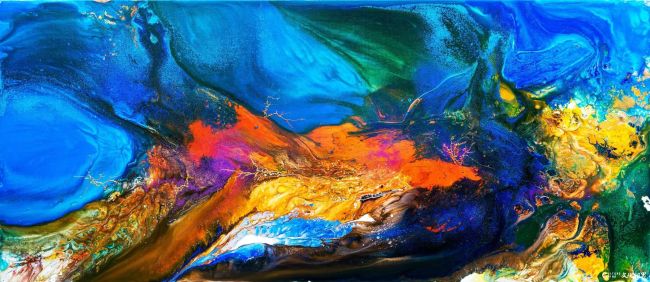曹俊先生的绘画令人恍若置身宇宙奇境。在他的笔下,传统中国水墨山水悄然幻化为浩瀚星云,在微观与宏观、东方古韵与西方当代之间,搭建起一场震撼心灵的跨时空对话。
The works of Cao Jun are a vertiginous plunge into a universe where traditional Chinese ink metamorphoses into cosmic nebulae, creating a striking dialogue between the infinitely small and the infinitely large, between the ancient Orient and the contemporary West.

《时间》90X207cm
附庸风雅者当谨记:当中国当代艺术以米其林盛宴般的面貌呈现时,这往往提示我们应重新审视艺术价值的测量范式、评价体系和审美趋势的预测机制。然而这位1966年生于江苏姜堰的艺术家——曹俊却不同凡响,他以令人惊叹的胆识突破了我们所有期待。
Listen to me carefully, you bunch of snobs, when Chinese contemporary art is served to us like a tasting menu in a Michelin-starred restaurant, carefully measured, politically acceptable and aesthetically predictable, it is generally a sign that we should be wary. But Cao Jun, this artist born in1966 in Jiangyan, Jiangsu province, is of a completely different caliber. He shatters our expectations with an audacity that makes the hairs on my forearms stand up.
欣赏他的"宇宙"系列,观者很难不被那深蓝与鎏金交织的宇宙漩涡所吞噬。曹俊不会温文尔雅地邀你赏景,而是猝不及防地将你推入画中。这不是礼貌的邀请,而是不可抗拒的召唤。
Look at his canvases from the "Universe" series and try not to feel drawn into a cosmic vortex of deep blues and flaming gold. Cao Jun is not the type to politely invite you to contemplate a landscape. No, he throws you in headfirst, without a lifebuoy. This is not an invitation, it is a summons.

《星际访客》90X207cm
令人称奇的是,他成功地将传统水墨技法与梦幻视界熔于一炉,这种融合甚至能让斯蒂芬·霍金为之动容。那些水墨飞溅仿佛蕴含着宇宙的遗传密码,从星云到黑洞,从螺旋星系到星爆,曹俊笔下的宇宙不是冰冷的现实,而是鲜活的梦幻体验。法国人素来赏识以智慧突破常规的人,曹俊正是这样的人,难怪他的“宇宙”系列在2013年法国卢浮宫国际美术展上斩获金奖。
The exquisite irony in this work lies in the way it manages to marry the ancestral technique of Chinese ink with a quasi-hallucinatory vision of space-time that would have delighted Stephen Hawking. These ink splashes seem to contain the very DNA of the universe. From nebulae to black holes, from spiral galaxies to star explosions, Cao Jun paints the cosmos not as an observed reality but as a lived psychedelic experience.It is no surprise that his “Universe" series won the gold medal at the Salon du Carrousel du Louvre in 2013. The French have always known how to recognize when someone was shaking up conventions with intelligence rather than gratuitous provocation. And that's exactly what Cao Jun does.
耐人寻味的是,这些宇宙景观既昭示着无限大,又暗喻着无限小。曹俊的抽象创作与道家哲学思想不谋而合,体现了老子“大与小相生相存”的哲学理念。在曹俊的“宇宙系列”中,他以视觉语言诠释了“道大,天大,地大,人亦大”的辩证关系。这令人想起波德莱尔《恶之花》中的“交感说”——“芳香、色彩、音响交相呼应”。曹俊在微观与宏观、具象与抽象间建立了类似的交感体验。透过他的水墨,观者既能鸟瞰河流三角洲,又可窥见哈勃望远镜捕捉的宇宙奇观。
But curiously, these cosmic explosions evoke for me as much the infinitely large as the infinitely small..Abstraction in Cao Jun refers to Taoist philosophy and this fundamental idea expressed by Lao Tseu that "the very small and the very large meet" [1]. In his paintings like "Turning Around the Universe" or "Opening and Closing". Cao Jun gives visual form to the Taoist maxim that "the lao is great, the heaven is great, the earth is great, and man is also great", four greatnesses that reflect each other.
This approach reminds me of Baudelaire's concept of "correspondences", when he wrote in Les Fleursdu Mal that “perfumes, colors and sounds correspond" [2]. Cao Jun establishes similar cogrespondences between microcosms and macrocosms, between the tangible and the ethereal. The streams of ink on his canvases can evoke both an aerial view of a river delta and a photograph taken by the Hubble telescope.

《永恒》210X500cm